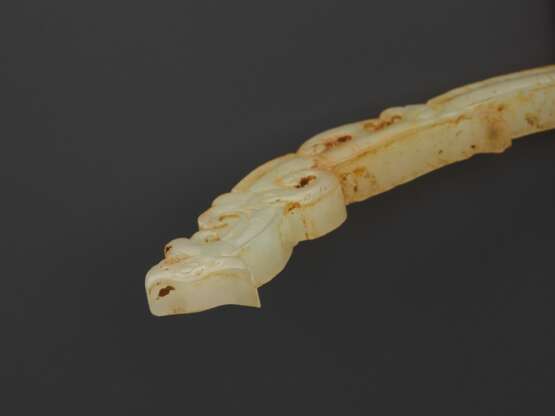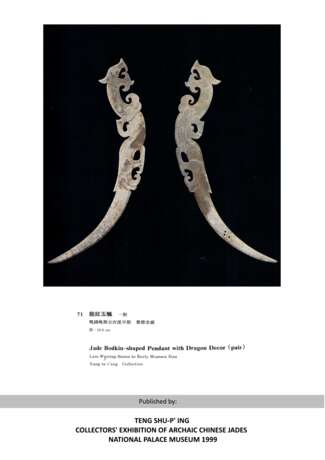KNOTENÖFFNER IN DRACHENFORM – GEGENSTÜCKE ZU DEN DRACHEN AM KÖNIGLICHEN NANYUE PEKTORAL
Startpreis
3500EUR € 3 500
AuktionsdatumClassic
28.04.2017 17:00UTC +02:00
Auctioneer
Galerie Zacke
Veranstaltungsort
Österreich, Wien
Archiv
Die Auktion ist abgeschlossen. Es können keine Gebote mehr abgegeben werden.

ID 957
Los 66 | KNOTENÖFFNER IN DRACHENFORM – GEGENSTÜCKE ZU DEN DRACHEN AM KÖNIGLICHEN NANYUE PEKTORAL
Jade
China
Östliche Zhou, 3. Jahrhundert vor bis frühe Han(ab 206 vor)
LÄNGE 8,6 CM, STÄRKE UM 6 MM
龍形玉刀。東周代,戰國時期,至漢代早期,公元前3世紀。長8.6厘米,厚約0.6厘米。維也納私人舊藏。
Zu diesem sehr fein gearbeiteten Knotenöffner gibt es berühmte sehr ähnliche Vergleichsstücke, u.a. am„Pectoral of a Concubine“(E124) aus dem Königsgrab von Nanyue. Ein weiteres ist abgebildet unter Nr. 71 in der Veröffentlichung der Collectors Exhibition of Archaic Jades im National Palace Museum, Beijing. Knotenöffner werden Xi genannt und wurden am Gürtel getragen. Das vorliegende elegant bogige Stück ist zur Gänze ein Drache undtrotz seiner Fragilität – perfekt erhalten. Der Kopf ist lebendig gebildet, Nase und Kinn amboßförmig. Der ganze Körper ist schlank und läuft in einem spitz endenden glatten Bogen aus. Entlang dem Körper sind mehrere Ansätze, bogig und mit Voluten oder spitz und mit dem gleichen Schwung wie der Schweif. Wenige feine Linien markieren die Mähne, auf dem glatten Drachenkörper findet sich nur sparsamer Dekor in Form einiger bogiger Haken oder Gitter. Sehr lichtgrüne Farbe der Jade, im Durchlicht weißlich.
Diese Jade wird in dem Buch von FILIPPO SALVIATI: “THE MYSTERIOUS STONE: Chinese Jades from the Neolithic to the Han in private collections” publiziert (Erscheinungstermin Frühjahr 2017).
Notes by Prof. Salviati: Elongated and slightly arched jades carved in the shape of dragons or phoenixes with a pointed end are traditionally known as xi or ‘knot-openers’: however, as many other jades, xi did not have an utilitarian function but were rather used as decorative pendants in composite ornaments formed by different jades, as attested by finds in Western and Eastern Zhou tombs. Xi remained in use until the Western Han period, when they were occasionally placed in the hands of the deceased: such is the case with Zhao Mo, the second ruler of the southern kingdom of Nanyue (2nd century BC). This xi is carved in a variety of white jade with almost no inclusions: the dragon has strong feline features and the body is finely detailed. A pair of very similar dragon-shaped xi, part of a five-piece set of ornaments in jade, has been discovered in the Nanyue tomb excavated at Guangzhou. The overall outline and design is similar to the present Lot, but the Nanyue jades are plainer, silhouette-like and lack the fine surface details of this xi. The same tomb has yielded another comparable jade which was found in the left hand of King Zhao Mo. In museum collections, a similar dragon-shaped xi is in the Freer/Sackler Galleries, acc. no. RLS1997.48.2135: http://www.asia.si.edu/collections/edan/object.php?q=fsg_RLS1997.48.2135 A second, very similar jade, originally in the collection of Alfred F. Pillsbury (1869-1950), is now in the Minneapolis Institute of Arts (acc. no.50.46.278): https://collections.artsmia.org/art/948/pendant-in-the-form-of-a-xi-tiger-china Compare also one in the National Palace Museum, Taipei, published in National Palace Museum 國立故宮博物院, Gugong gu yu tu lu 故宫古玉圖錄 (Illustrated Catalogue of Ancient Jade Artefacts), National Palace Museum, Taipei 1988.
Expertise: Wolfmar Zacken & Filippo Salviati
Aus einer Wiener Sammlung
| Adresse der Versteigerung |
Galerie Zacke Mariahilferstrasse 112 1070 Wien Österreich | ||||||||||||||
|---|---|---|---|---|---|---|---|---|---|---|---|---|---|---|---|
| Vorschau |
| ||||||||||||||
| Telefon | +00 4315-320 452 | ||||||||||||||
| Fax | +43-1-5320452-20 | ||||||||||||||
| Aufgeld | 27.000 | ||||||||||||||
| Nutzungsbedingungen | Nutzungsbedingungen | ||||||||||||||
| Geschäftszeiten | Geschäftszeiten
|





